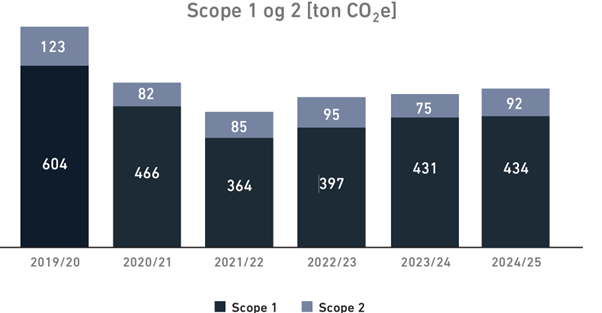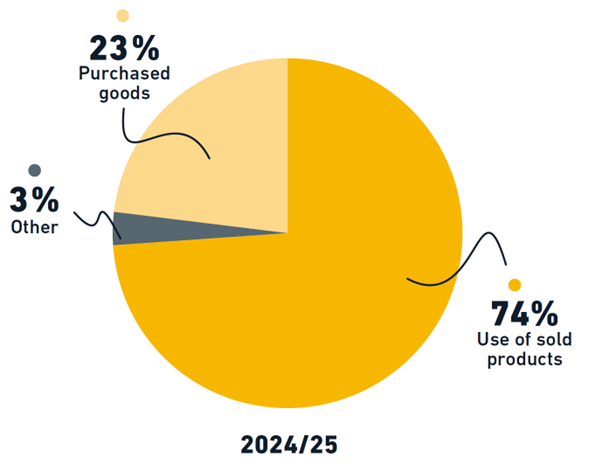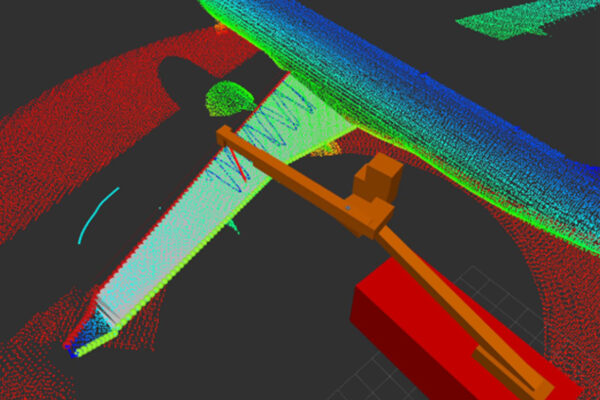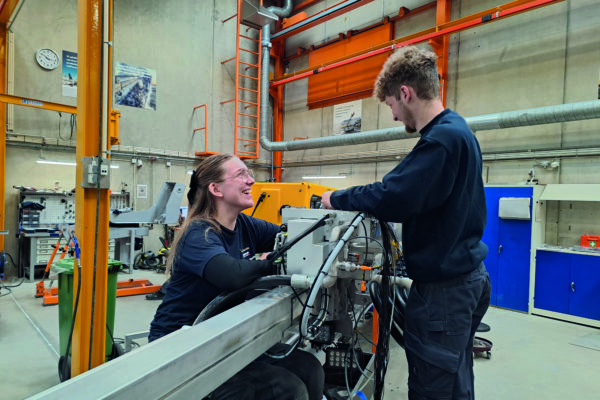June 24, 2025
Since 2014 Vestergaard Company A/S has reported on the company’s greenhouse gas emissions. We base our calculations on the methodology of ‘The Greenhouse Gas (GHG) Protocol – A Corporate Accounting and Reporting Standard,’ a widely recognized and used standard within GHG accounting and reporting. The GHG protocol categorizes a company’s greenhouse gas emissions into three scopes:
- Scope 1 includes direct emissions from activities under our control, such as the consumption of natural gas, fuel oil and transport diesel.
- Scope 2 covers indirect emissions from the production of purchased electricity or other energy, e.g., district heating.
- Scope 3 includes all other indirect emissions in our value chain, upstream and downstream. Examples are extraction and production of purchased materials, transport of purchased and sold products and use of sold products.
Scope 1 and 2
With an ambitious goal of reducing our scope 1 emissions by 70% by 2025/26 compared to the base year 2019/20, we are already fully engaged in various initiatives, as outlined in the sustainability report. As of now, these have resulted in a reduction in our direct emissions of approximately 28% compared to the base year 2019/20. This marks a slight setback compared to last year – despite the near-complete phase-out of natural gas consumption. The increase in scope 1 emissions is due to increased production activity and, as a result, higher use of diesel for testing our deicers. We are maintaining a strong focus on minimising diesel usage and have continuously worked to optimise our test phase. In the latest financial year, we introduced systematic registration of diesel refuelling, which now forms the basis for ongoing analysis and new reduction initiatives.
Our scope 2 emissions have also increased. This is a result of higher electricity consumption caused by the transition from natural gas to geothermal heating and heat pumps – a shift we consider both positive and future-oriented. We aim to expand our solar panel installation, with the ambition to cover 25–30% of our total electricity consumption (compared to 12% in the latest fiscal year). To further strengthen our use of renewable energy, we have signed a Power Purchase Agreement (PPA) with the energy company Reel. The agreement ensures that from 2026 onwards, we will contribute directly to the construction of new wind turbines and receive green electricity from that specific source. In the coming year, scope 2 is also expected to be included in the company’s CO2 reduction target.

Scope 3
This is the second year we are presenting our carbon accounting for the entire value chain (also known as scope 3), which represents more than 99% of our total CO₂ emissions. Over the past year, we have worked on improving the data foundation so that an increasing share of the data now comes directly from the source. We are far from finished, but over the coming years, we will continue to work toward developing even more robust and reliable carbon accountings.
The largest share of our scope 3 emissions stems from the use of diesel and electricity in operating our products at the customer’s site. For many years, we have focused on optimizing energy efficiency and electrifying our products, which now consume significantly less diesel than before. Continuing this effort remains a top priority at Vestergaard Company.
The second-largest category is the purchasing of products and materials, particularly steel. Over the past year, we have initiated a collaboration with the Technical University of Denmark (DTU) to develop life cycle analyses and launched a project with the Danish Technological Institute focused on sustainable service concepts – both with the aim of reducing the negative impact in our value chain.
The remaining minor categories, which together account for only 3%, have been grouped into one. Still, they remain important, as they contain potential low-hanging fruits for further reductions in our climate impact. We have already initiated actions in some of these areas and plan to set targets and initiatives across all relevant categories in the coming years.

Method and data
The carbon accounting follows the methodology of ‘The Greenhouse Gas (GHG) Protocol – A Corporate Accounting and Reporting Standard,’ which is recognized as best practice within carbon accounting. The consolidation approach is the operational control, however, the scope 3 accounting currently only includes our Danish productions site, as this is by far the largest, and the rest of our production sites will be included over the next years.
Scope 1
Data on the use of natural gas and fuel oil is retrieved from online supplier portals and invoices. It is assumed that gas and oil are used in the same fiscal year as it is bought.
Data on the ICE company cars are incomplete. For the passenger vehicles, an estimate is used based on the distance from the user of the car’s house and the company address. For the service vans we base our calculation on the kilometer reading of the vans.
The emission factors for burning of natural gas, fuel oil, diesel and gasoline are from Klimakompasset. The emission factors for the latest year are typically not yet available when we finish our carbon accounting, and therefore the emission factors for the previous year are used, until the latest value is available.
Data on welding gas and truck gas is retrieved from invoices, and scope 1 emission factors are based on balancing of chemical equations. It is assumed that the gas is used in the same fiscal year as it is bought.
Scope 2
Data on electricity use is retrieved from online supplier portals and invoices.
Data on the electrical company cars are retrieved from the provider of the charging stations.
The emission factors (location- and market based) for electricity is from Klimakompasset. The emission factor for the latest year is typically not yet available when we finish our carbon accounting, and therefore the emission factor for the previous year is used, until the latest value is available.
Scope 3
The scope 3 calculations involve many estimates and uncertainties. A crucial part of the process is continuously improving the data foundation to make the calculations more precise and accurate.
1 Purchased goods and services
The calculation of the CO2-emissions from purchased goods and services is mainly based on data from our ERP-system. Where data on the weight of the materials is available, this has been used, and for the rest, the amount spend on purchased goods has been used (approximately a 50/50 split between weight and spend – an improvement from the 40/60 split last year). As we have a large number of suppliers, we have used the method from the GHG protocol of prioritizing suppliers based on their contribution to the company’s total spend. We have selected the largest tier 1 suppliers that collectively account for at least 80% of our total spend or that are of special interest to us.
Additionally, some suppliers have delivered complete reports of the CO2-emissions associated with our purchase from them. This amount to approximately 12% of the total category 1 emissions.
The emission data consists of primary data from suppliers (EPDs, PCFs etc.) and secondary data from databases (both activity and spend-based emission factors). Additionally, some primary data from suppliers have been used on similar products from other suppliers. The primary database used is Klimakompasset.
Currently, the available data on purchased services such as accounting or consultancy is of a quality so low, that we have chosen not to include this category in the calculations. This category amounts to a minor part of the total purchase, but will however be included at a later stage, when we have gathered the necessary data.
3 Fuel- and energy-related activities
The data on fuel and energy use is the same as for the scope 1 and 2 emission calculations. The used emission factors are from Klimakompasset.
4 Upstream transportation and distribution
This category includes all transport from our tier 1 suppliers to our site. Our data on this transport is currently very limited. Most of the transportation is handled by our suppliers and only a few suppliers are able to deliver data on the transportation. For the large parts we purchase, the weight of the products and the distance to the suppliers combined with an emission factor from Klimakompasset have been used. This amounts to the majority of the upstream transport (>95%). For the rest (the small parts) the calculation is spend-based with an emission factor based on an average from the suppliers from which we have received data on transportation.
5 Waste generated in operations
99% of the waste generated in our operation is recycled or recovered as energy. This is not, however, included in the scope 3 emissions according to the GHG protocol. The waste included in this category is therefore our wastewater and the waste we send to landfill. The amount of wastewater is based on the amount of used water, which is retrieved from invoices. The amount of waste to landfill is retrieved from the waste management company’s online portal. The emission factor is from Klimakompasset.
6 Business travel
The majority of business travels are booked through a travel management company from which we receive data on emissions from the transportation and the hotel stays that our employees have used. A minor amount of business travels is conducted outside the management company, for which we do not have any data.
Category 7: Employee commuting
A survey was conducted in 2023 where information on our employees’ distance to work and preferred means of transport was collected. This data is combined with the average number of employees throughout the fiscal year and emission factors from Klimakompasset.
Category 9: Downstream transportation and distribution
The majority of this category is the transportation of our products such as deicers and water- and toilet-trucks, which is primarily transported on own wheels or by truck and ship. The data on this transportation is currently very limited, and based on an average distance to our customers, the number of sold products and emission factors from Klimakompasset.
A minor part is the transportation of spare parts, which is primarily transported by aircraft. Emission data on this transportation is received from the distribution firm on a quarterly basis and thus the data is offset by one month in relation to the fiscal year.
- Use of sold products
The data on use of our sold products is currently limited. Our products use two types of energy: some use diesel oil, some use electricity, and some use both. The data on the energy use is retrieved from customers, but the datasets are in most cases small, and estimates and assumptions have been necessary.
The emission factors for diesel and electricity are based on an average of the estimated emission factors in Klimakompasset for the coming years equaling the lifetime of the products.
Categories not included
Some of the 15 scope 3 categories are not relevant to our company and some are temporarily excluded due to lack of data. Below is a table with the seven scope 3 categories that we have not yet included in our scope 3 calculations and the reason for this.
| Categories not included | Reason |
| 2 Capital goods | Currently included in “1 Purchased goods” due to difficulties in separating these. This is expected to be done in 2025/26. |
| 8 Upstream leased | We do not operate any leased assets which are not included in our scope 1 or 2 inventories. |
| 10 Process. of sold products | Our products are sold directly to the customer, and there is no processing by a downstream value chain partner. |
| 12 EoL sold products | We don’t have any knowledge or data on this category currently. Data collection on EoL is ongoing and reporting is expected in 2025/26. |
| 13 Downstream leased | We do not lease any assets to other entities. |
| 14 Franchises | We do not act as franchisors in any way. |
| 15 Investments | We do not have investments not included in scope 1 or 2. |
We are far from finished, but we will work over the coming years to develop even better carbon accounts.





